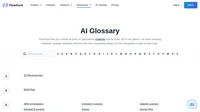Recurrent Neural Networks (RNNs) are a sophisticated class of artificial neural networks designed for processing sequential data. Unlike traditional feedforward neural networks that process inputs in a single pass, RNNs have a built-in memory mechanism that allows them to maintain information about previous inputs, making them particularly well-suited for tasks where the order of data is crucial, such as language modeling, speech recognition, and time-series forecasting.
What Does RNN Stand For in Neural Networks?
RNN stands for Recurrent Neural Network. This type of neural network is characterized by its ability to process sequences of data by maintaining a hidden state that gets updated at each time step based on the current input and the previous hidden state.
Definition of Recurrent Neural Network (RNN)
A Recurrent Neural Network (RNN) is a type of artificial neural network where connections between nodes form a directed graph along a temporal sequence. This allows it to exhibit dynamic temporal behavior for a time sequence. Unlike feedforward neural networks, RNNs can use their internal state (memory) to process sequences of inputs, making them suitable for tasks like handwriting recognition, speech recognition, and natural language processing.
Concept of a Recurrent Neural Network
The core idea behind RNNs is their ability to remember past information and use it to influence the current output. This is achieved through the use of a hidden state, which is updated at every time step. The hidden state acts as a form of memory that retains information about previous inputs. This feedback loop enables RNNs to capture dependencies in sequential data.
Architecture of RNN
The fundamental building block of an RNN is the recurrent unit, which consists of:
- Input Layer: Takes in the current input data.
- Hidden Layer: Maintains the hidden state and updates it based on the current input and the previous hidden state.
- Output Layer: Produces the output for the current time step.
Types of RNNs
RNNs come in various architectures depending on the number of inputs and outputs:
- One-to-One: Similar to a standard neural network, with one input and one output.
- One-to-Many: One input leads to multiple outputs, such as image captioning.
- Many-to-One: Multiple inputs produce a single output, such as sentiment analysis.
- Many-to-Many: Multiple inputs and outputs, such as machine translation.
Uses of Recurrent Neural Networks
RNNs are incredibly versatile and are used in a wide range of applications:
- Natural Language Processing (NLP): Tasks like language modeling, machine translation, and text generation.
- Speech Recognition: Converting spoken language into text.
- Time-Series Forecasting: Predicting future values based on previously observed values.
- Handwriting Recognition: Recognizing and converting handwritten text into digital form.
Example Applications
- Chatbots and Virtual Assistants: Understanding and responding to user queries.
- Predictive Text: Suggesting the next word in a sentence.
- Financial Market Analysis: Predicting stock prices and market trends.
How RNN Differs from Feedforward Neural Networks
Feedforward neural networks process inputs in a single pass and are typically used for tasks where the order of data is not important, such as image classification. In contrast, RNNs process sequences of inputs, allowing them to capture temporal dependencies and retain information across multiple time steps.
Advantages and Challenges of RNNs
Advantages
- Sequential Data Processing: Efficiently handles tasks involving sequences.
- Memory Capability: Maintains information about past inputs to inform future outputs.
Challenges
- Vanishing Gradient Problem: Difficulty in learning long-term dependencies due to gradients that diminish over time.
- Complexity: More computationally intensive compared to feedforward networks.
Advanced RNN Architectures
To address some of the limitations of traditional RNNs, advanced architectures like Long Short-Term Memory (LSTM) and Gated Recurrent Unit (GRU) have been developed. These architectures have mechanisms to better capture long-term dependencies and mitigate the vanishing gradient problem.
Artificial Neural Networks (ANNs)
Explore Artificial Neural Networks (ANNs) and discover their role in AI. Learn about types, training, and applications across various industries.



